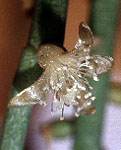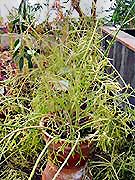|
Rhipsalis teres (Vellozo) Steudel, Nom. ed. 2.2: 449.
(1841)
|
|
|
Right: R. teres, Brussels Botanical Garden. |
Desc from B&R 1923 Plant
- stems erect or spreading, woody at base, 10 to 12 mm. in diameter,
much branched, especially above, with 5 to 12 short ultimate branches
at top of main ones; forma teres |
| Notes from Bradleya 13 DISTRIBUTION. Brazil (Minas Gerais, Rio de Janeiro, Sao Paulo, Parana, Santa Catarina,Rio Grande do Sul): at < 1000 m altitude. The late Clarence Horich has supplied the Bonn collection with living material of this species said to have been collected in Costa Rica, but it may be doubted that it is truly native there (perhaps introduced?). The CITES Cactaceae Checklist (Hunt 1992) records it for Colombia and Venezuela, but these records are now thought to refer to highly branched variants of R. baccifera, similar to that newly described as R. baccifera subsp. hileiabaiana. The highly variable R. teres comprises many ecotypic forms, of which three extremes deserve recognition. Desc from Hunt 2006. |
|

